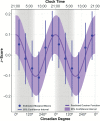The Influence of Circadian Timing on Olfactory Sensitivity
- PMID: 29045623
- PMCID: PMC5863568
- DOI: 10.1093/chemse/bjx067
The Influence of Circadian Timing on Olfactory Sensitivity
Abstract
Olfactory sensitivity has traditionally been viewed as a trait that varies according to individual differences but is not expected to change with one's momentary state. Recent research has begun to challenge this position and time of day has been shown to alter detection levels. Links between obesity and the timing of food intake further raise the issue of whether odor detection may vary as a function of circadian processes. To investigate this question, 37 (21 male) adolescents (M age = 13.7 years) took part in a 28-h forced desynchrony (FD) protocol with 17.5 h awake and 10.5 h of sleep, for 7 FD cycles. Odor threshold was measured using Sniffin' Sticks 6 times for each FD cycle (total threshold tests = 42). Circadian phase was determined by intrinsic period derived from dim light melatonin onsets. Odor threshold showed a significant effect of circadian phase, with lowest threshold occurring on average slightly after the onset of melatonin production, or about 1.5○ (approximately 21:08 h). Considerable individual variability was observed, however, peak olfactory acuity never occurred between 80.5○ and 197.5○ (~02:22-10:10 h). These data are the first to show that odor threshold is differentially and consistently influenced by circadian timing, and is not a stable trait. Potential biological relevance for connections between circadian phase and olfactory sensitivity are discussed.
Keywords: adolescents; food intake; forced desynchrony; individual differences; odor threshold; trait-state.
© The Author(s) 2017. Published by Oxford University Press. All rights reserved. For permissions, please e-mail: journals.permissions@oup.com.
Figures




References
-
- Acebo C, LeBourgeois MK. 2006. Actigraphy. Respir Care Clin N Am. 12:23–30, viii. - PubMed
-
- Achenbach TM, Rescorla LA. 2001a. Manual for the ASEBA Child Behavior Checklist for Ages 6–18. Burlington (VT): Research Center for Children, Youth, and Families, University of Vermont.
-
- Achenbach TM, Rescorla LA. 2001b. Manual for the ASEBA Youth Self-Report for Ages 11-18. Burlington (VT): Research Center for Children, Youth, and Families, University of Vermont.
-
- Carskadon MA, Acebo C, Richardson GS, Tate BA, Seifer R. 1997. An approach to studying circadian rhythms of adolescent humans. J Biol Rhythms. 12:278–289. - PubMed
Publication types
MeSH terms
Grants and funding
LinkOut - more resources
Full Text Sources
Other Literature Sources

